Acetyl-glycine ethyl ester is widely utilized in research focused on:
- Pharmaceutical Development: This compound serves as an intermediate in the synthesis of various pharmaceuticals, particularly those targeting metabolic disorders, enhancing drug efficacy and bioavailability.
- Biochemical Research: It is employed in studies related to amino acid metabolism, helping researchers understand metabolic pathways and the role of acetylation in biological processes.
- Cosmetic Formulations: The compound is used in the formulation of skin care products due to its moisturizing properties, providing a smoother texture and improved skin hydration.
- Food Industry: It acts as a flavoring agent, contributing to the enhancement of taste profiles in food products, making them more appealing to consumers.
- Analytical Chemistry: Acetyl-glycine ethyl ester is utilized as a standard in chromatography, aiding in the accurate analysis of complex mixtures in various samples.
General Information
Properties
Safety and Regulations
Applications
Acetyl-glycine ethyl ester is widely utilized in research focused on:
- Pharmaceutical Development: This compound serves as an intermediate in the synthesis of various pharmaceuticals, particularly those targeting metabolic disorders, enhancing drug efficacy and bioavailability.
- Biochemical Research: It is employed in studies related to amino acid metabolism, helping researchers understand metabolic pathways and the role of acetylation in biological processes.
- Cosmetic Formulations: The compound is used in the formulation of skin care products due to its moisturizing properties, providing a smoother texture and improved skin hydration.
- Food Industry: It acts as a flavoring agent, contributing to the enhancement of taste profiles in food products, making them more appealing to consumers.
- Analytical Chemistry: Acetyl-glycine ethyl ester is utilized as a standard in chromatography, aiding in the accurate analysis of complex mixtures in various samples.
Documents
Safety Data Sheets (SDS)
The SDS provides comprehensive safety information on handling, storage, and disposal of the product.
Product Specification (PS)
The PS provides a comprehensive breakdown of the product’s properties, including chemical composition, physical state, purity, and storage requirements. It also details acceptable quality ranges and the product's intended applications.
Certificates of Analysis (COA)
Search for Certificates of Analysis (COA) by entering the products Lot Number. Lot and Batch Numbers can be found on a product’s label following the words ‘Lot’ or ‘Batch’.
*Catalog Number
*Lot Number
Certificates Of Origin (COO)
This COO confirms the country where the product was manufactured, and also details the materials and components used in it and whether it is derived from natural, synthetic, or other specific sources. This certificate may be required for customs, trade, and regulatory compliance.
*Catalog Number
*Lot Number
Safety Data Sheets (SDS)
The SDS provides comprehensive safety information on handling, storage, and disposal of the product.
DownloadProduct Specification (PS)
The PS provides a comprehensive breakdown of the product’s properties, including chemical composition, physical state, purity, and storage requirements. It also details acceptable quality ranges and the product's intended applications.
DownloadCertificates of Analysis (COA)
Search for Certificates of Analysis (COA) by entering the products Lot Number. Lot and Batch Numbers can be found on a product’s label following the words ‘Lot’ or ‘Batch’.
*Catalog Number
*Lot Number
Certificates Of Origin (COO)
This COO confirms the country where the product was manufactured, and also details the materials and components used in it and whether it is derived from natural, synthetic, or other specific sources. This certificate may be required for customs, trade, and regulatory compliance.


